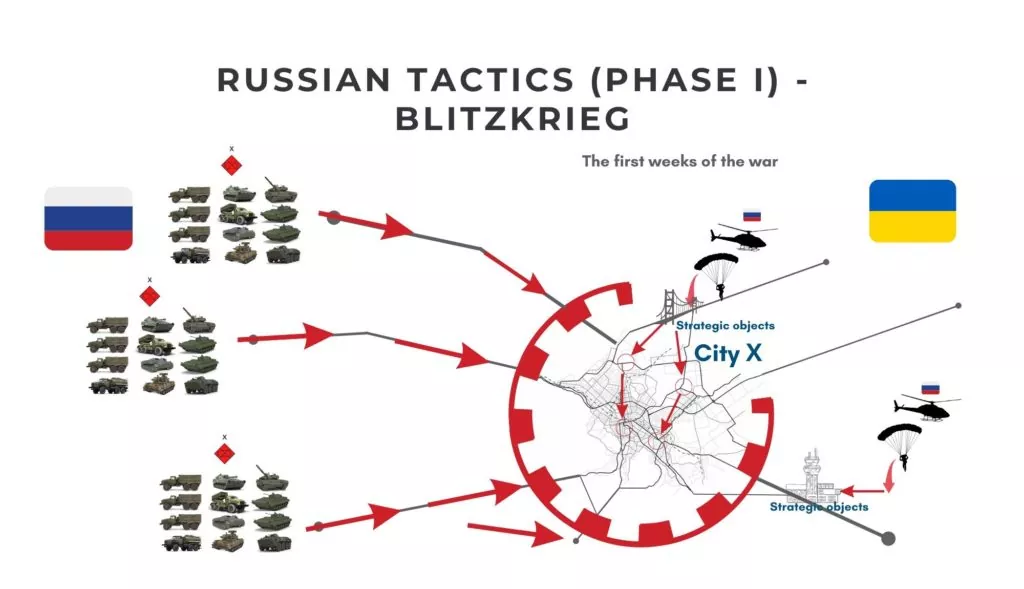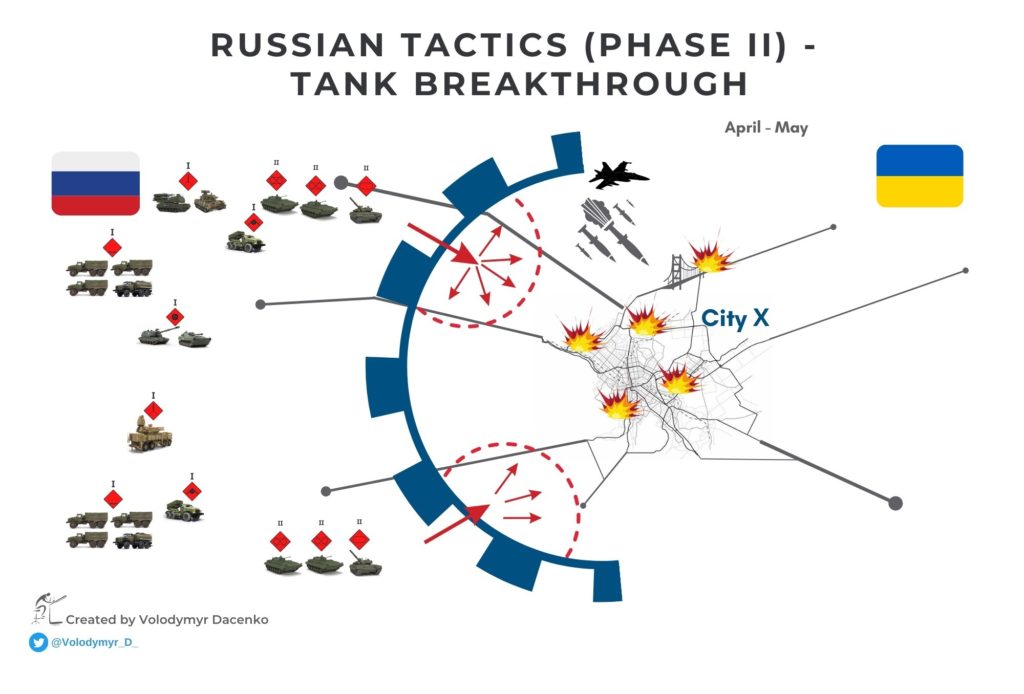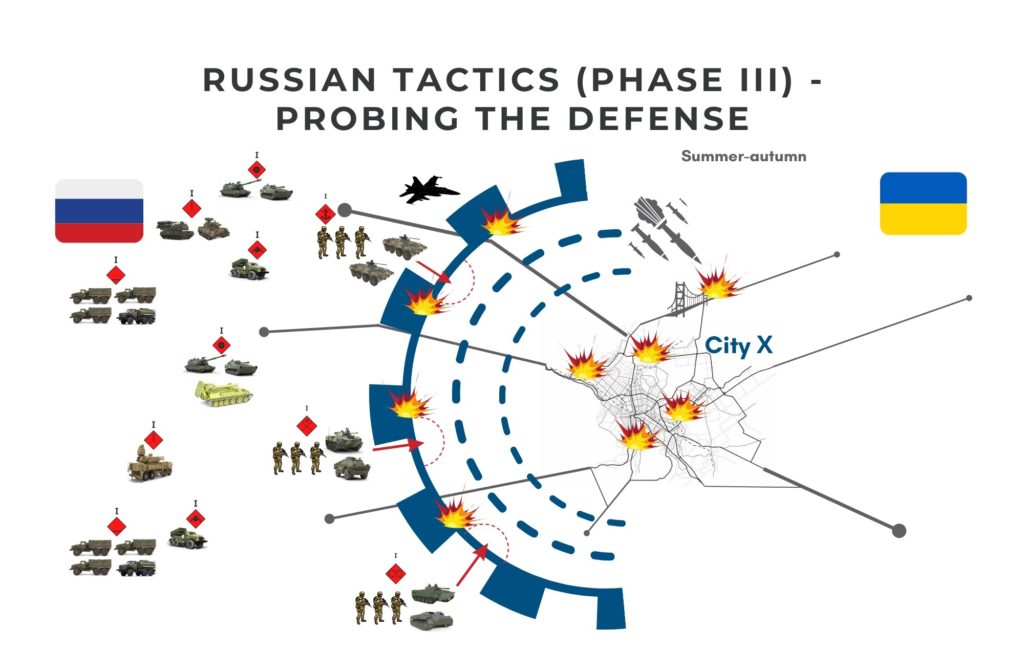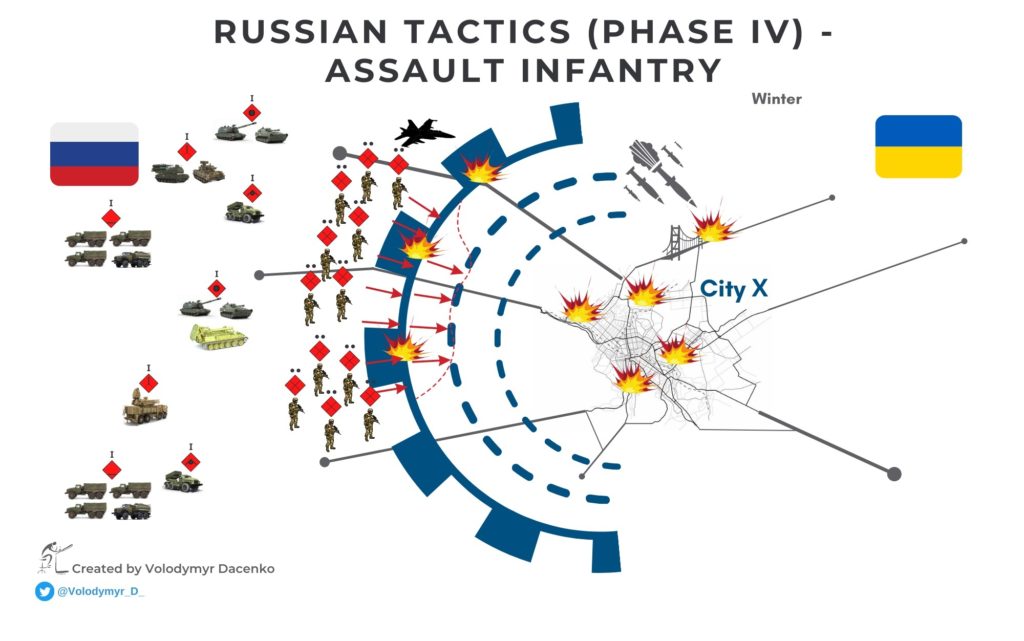The General Staff of the Russian army has employed different methods to carry out offensive operations since February 2022, when Russia launched its large-scale invasion of Ukraine. Some of the approaches used by the Russian military command helped Russia occupy vast swathes of Ukrainian territory, while others failed completely. In a Twitter thread, Dacenko outlined what tactics the Russian forces stick to during the war and how Ukraine deals with that. Here are his main points.
Russia's large-scale invasion of Ukraine can be divided into four phases, each having a different tactical approach employed by the Russian command:
- Russian tactics during Phase I: Blitzkrieg
- Russian tactics during Phase II: Tank breakthrough
- Russian tactics during Phase III: Probing the defense
- Russian tactics during Phase IV: Assault infantry
Phase I: Failed blitzkrieg
Initially, the Russian attack was planned as a large-scale rapid operation from the air, land, and water. It comprised four acts that unfolded during the first weeks of the war.
Act 1
implied a large-scale missile attack that was supposed to suppress the Ukrainian air defense system and create chaos in defense management.

Russian tactics during the first stage of the invasion. Infographic by Volodymyr Dacenko/Twitter
During the Act 2 the main role was planned for amphibious operations. The aim of such operations was to quickly capture key objects and government buildings in the main Ukrainian cities, such as the capital Kyiv, the second-largest city Kharkiv and the Black Sea port Odesa. Russian forces planned to use hundreds of helicopters, at least 18 large Il-76 planes and a naval landing force.
To capture Kyiv, it was planned to land several hundred paratroopers on 24 Mi-8 transport helicopters accompanied by ten Mi-24, Ka-52 combat helicopters and 12 fighter jets in Hostomel (the airfield north of Kyiv).
Next, Hostomel was to become a base to receive large Il-76 transport planes carrying the main forces of the amphibious operation. In a matter of hours, Russian troops were to break into Kyiv and seize the main administrative buildings.
During the Act 3 large convoys of armored vehicles were to block off key cities from support and suppress resistance. It was obvious that the landing party itself would not be able to hold its position for a long time. Huge columns of armored vehicles went to support them.
Armored troops were supposed to blockade all major cities, set up checkpoints and cut logistical routes to support the Ukrainian army. Cleaning of cities and suppression of public actions was to be ensured by the Russian Guard, which marched in the same echelon as the tanks.
The Act 4 implied the encirclement of Ukrainian troops in the East. The main Ukrainian forces (according to the Kremlin's plan) were to remain blocked in the east of Ukraine. The troops of the so-called Donetsk People's Republic and Luhansk People's Republic (Ukrainian territories of the Donbas region occupied by the Russian forces back in 2014) were to distract Ukraine's Armed Forces with numerous attacks.
Millions of Dutch chips end up in Russia despite EU sanctions – NOS/Nieuwsuur investigation
In a few days, the Ukrainian defense was to lose combat capability. It was supposed to be paralyzed and cut off from the supply of Ukraine's rear. Finally, the Ukrainian government was planned to be destroyed or forced to accept capitulation.
It is not correct to say that this plan was completely wrong and failed everywhere. It worked in the South, where Ukraine's air defense was the weakest and there was a lack of coordination between Ukrainian units. In particular, this tactic proved to be successful in Kherson Oblast in southern Ukraine and allowed Russian forces to capture the city of Kherson.
According to the Ukrainian military command, it was not possible to build the effective defense of Kherson because the Russian landing force seized bridges and other key logistics facilities in the Kherson Oblast in the early hours of the large-scale invasion. Ukrainian troops had to make their way to the western bank of the Dnipro River in order not to be surrounded by the Russian forces.
Meantime, in the North such tactics of the Russian command turned out to be a failure. The main reason for this implied two factors: the preservation of the Ukrainian anti-aircraft defense capability and fierce local resistance. The resistance of Ukrainian cities in the North of the country managed to cut off significant Russian forces from fuel and ammunition supplies.
Despite the Russian massive aerial bombardment and artillery shelling, such cities as Chernihiv, Pryluky, Putivl, Glukhiv, etc. were not captured by Russia. Without them, Russia lost the chance to block Kyiv.
Phase II: Rapid tank breakthrough
In April and May, the Russian forces changed their tactics. They regrouped and switched to classic Soviet warfare relying heavily on massive artillery fire. After that, the battalion tactical groups of the Russian forces (BTG) carried out a concentrated attack, trying to break through the defense line and create a bridgehead for the development of their advance.

This tactic has a strong resemblance to that of the World War II. However, in the conditions where the enemy can see the battlefield and all manoeuveres from drones and satellites, any large armored column becomes an easy target for artillery.
The last attack in this style was carried out by the Russian forces near Bilohorivka (Luhansk Oblast, eastern Ukraine) in May 2022. When fording the river, the Russians lost up to 100 units of armored vehicles. After that, Russia did not attempt to carry out such attacks again.
Phase III: Probing the defense before a large-scale assault
Since June 2022, Russia has mostly attacked in small groups (several tanks and infantry fighting vehicles). Marines and VDV forces (Special operations forces of the Russian army) were more often involved in such attacks. Their task was not to break through the defense line, but to find a weak spot in the defense.

This tactic was the most successful in the direction of Popasna (Donetsk Oblast, eastern Ukraine) and Lysychansk (Luhansk Oblast, eastern Ukraine), where the Russians managed to relatively quickly conquer a significant territory due to the disadvantageous position of the Ukrainian forces.
However, this tactic was marked with a number of painful failures and heavy losses of the Russian army. The last failed attempt to employ such tactic took place near Pavlivka (Vuhlerdar) in Donetsk Oblast during the assault of the Russian forces that ended up with heavy losses for the Russian side.
In autumn, most of the professional troops of the Russian army, including marines and landing forces, suffered heavy losses. Many tanks and armored vehicles were also lost. Russia could no longer afford to carry out assaults by VDV and marines.
Phase IV (ongoing): Assault infantry
In winter, the Russian forces switched to the World War I tactics relying heavily on infantry and artillery. The Russians try to push out the Ukrainian units and occupy their trenches. After that, Russian forces advance and storm the next trenches.

This creeping occupation has been going on for two months. The Russians lose a lot of infantry. But the assault units actually have no value for the Kremlin. After all, these are mostly convicts from Russian prisons recruited by the mercenary group Wagner. They are followed by "cheap" mobilized soldiers, to whom Russia issued old Soviet-era helmets and bulletproof vests. Minimum costs for each soldier.
The mobilized must hold the occupied positions and repulse the counterattacks of the Ukrainian forces. Russia employs such tactic during the assaults on Bakhmut and Soledar in Donetsk Oblast. While Bakhmut still holds, Soledar has already fallen.
Western weapon delays may have cost Ukraine its winter counteroffensive – ISW
Whether Russia can win the war relying on the assault infantry only remains unclear. Ukraine needs more high-precision weaponry and armor to deal with the tactics that Russia employs at this stage of the war.
Related:
- Ukraine is gaining the upper hand. But it needs more help
- Battle of Soledar: how can Ukraine stop Russia?
- Ukraine to liberate Crimea by end of August 2023 - Ben Hodges
- German Rheinmetall ready to boost production of tank and artillery rounds
- Ukraine is to receive a total of 80 battle tanks from Europe
- Ukraine asks for longer range missiles, necessary for counteroffensive

